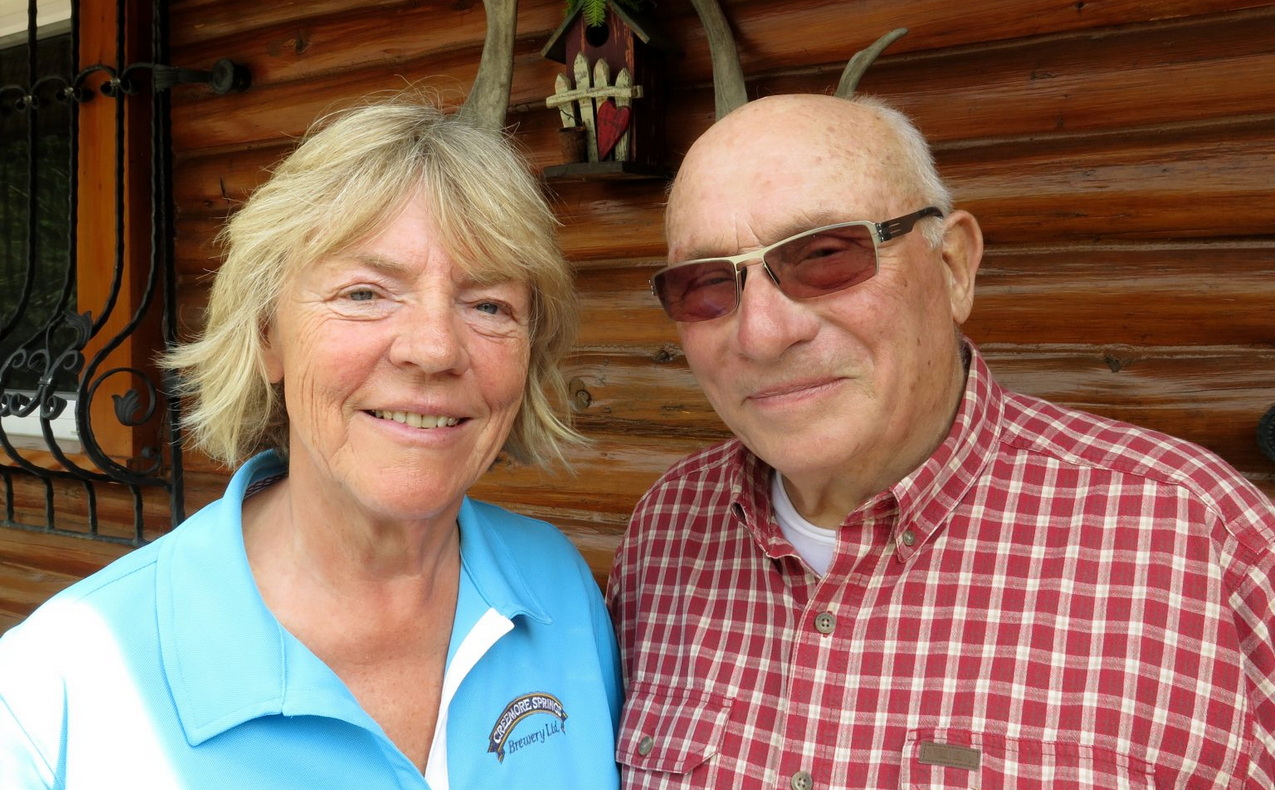Have you ever wanted an off-grid solar system to power your home or cottage? How about wind energy? I’d like to tell you about a couple who built an off-grid energy system way back in 1998 that’s been powering a modern lifestyle ever since.
Off-grid solar systems and wind turbine systems are more practical than ever these days and I’ve helped hundreds of ordinary people gain self-reliance by getting off the grid.
Solar panels, wind turbines and more
When Anne and Fritz Kettling decided to build their dream home on a rural island back in the 1980s, they weren’t willing to compromise on location.
“If I can’t build on this property, I don’t want to build at all,” Fritz told a real estate agent who was trying to convince him to look at less remote pieces of land to buy.
That was more than 30 years ago and, true to his word, Fritz built where he wanted to and lived there. The project came with challenges, of course, and one of the biggest was getting electricity to their place when the nearest utility pole was more than 15 kilometres away.
Fritz told me that a connection to power lines would have cost $360,000 in the late 1980s (more than $724,000 in 2022 dollars), plus he’d have to pay for utility power forever after that. Naturally, Fritz and Anne said, “No, thanks,” then got to work creating their own alternative, renewable power system — before it was as mainstream as these things are now.
Sadly, Fritz has since passed away, and Anne has sold the place. But the system they lived with is still working fine and a great example of an off-grid solar system that really works.
Using renewable energy sources
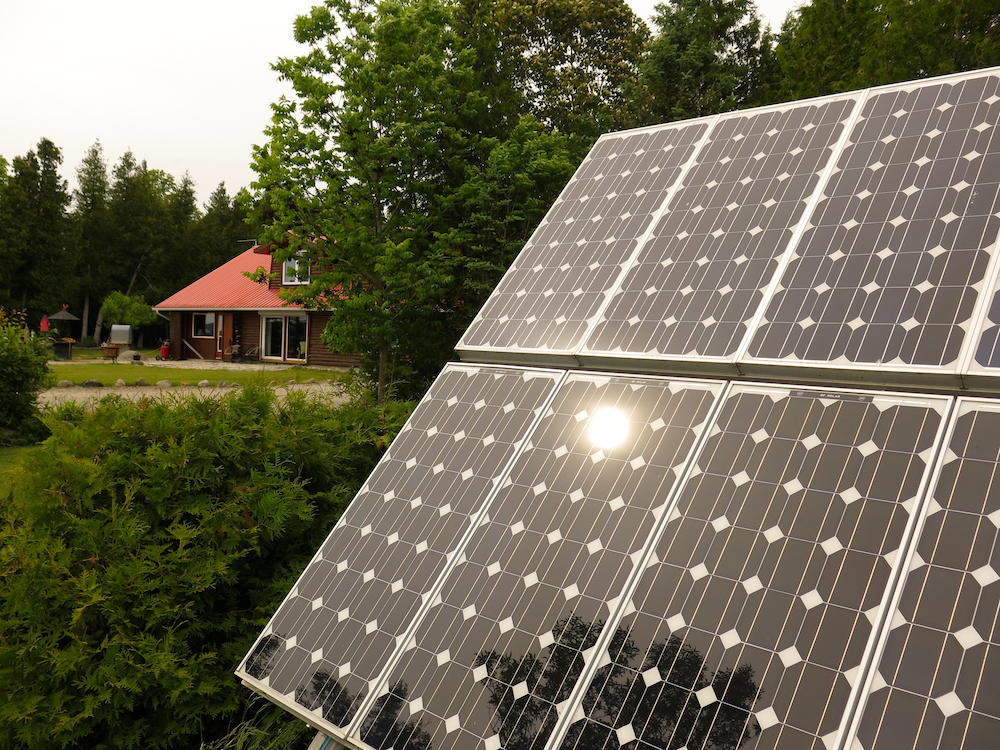
The renewable off-grid solar system I’m telling you about here is coupled with a windmill, a bank of batteries, a charge controller and an inverter to create enough AC power for a modern home. Total renewable power output is 10,000 watts, and the original batteries, wind turbine and PV panels are still working perfectly today.
The Kettlings’ experience is especially useful for anyone looking to create a large, full-featured renewable power system.
Their bank of mono-crystalline solar panels puts out 1,400 watts on a sunny day. That’s the array of panels Fritz installed at his place shown above. The Bergey wind turbine has been putting out 1,500 watts of peak power year in and year out without need for servicing. That’s it below.
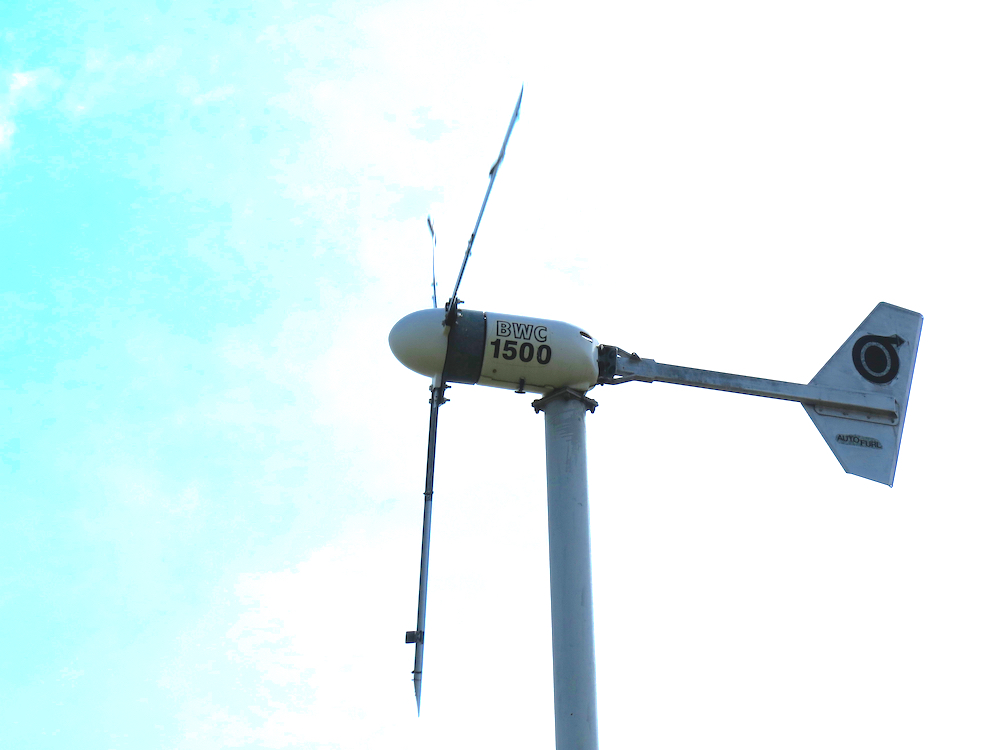
Since the Kettlings were entirely responsible for creating power on their own, they also installed a propane-fired backup generator just in case (shown below).
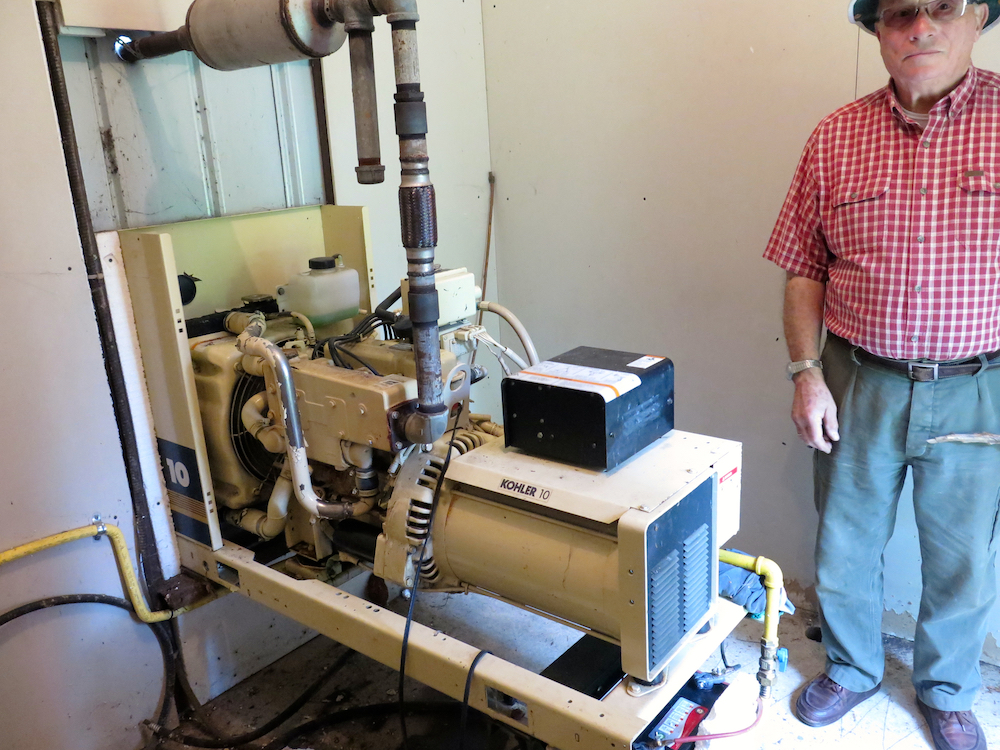
Any full-time, off-grid power system should have a backup generator. This one is much larger than they needed, but Fritz wanted something that could power the industrial-sized metalworking equipment he had in his shop.
Solar panel overview
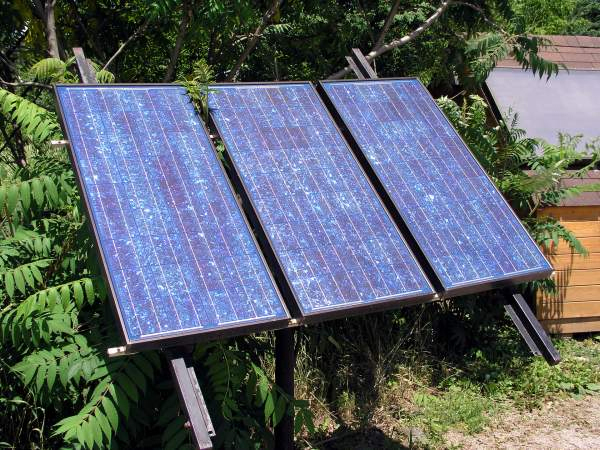
Solar panels provide about half of the renewable power in the Kettlings’ system. The other half comes from their wind turbine. The solar side of the system uses ground-mounted, mono-crystalline photovoltaic (PV) panels that sit on a fixed stand.
The stand keeps the panels high enough to be safe, yet low enough for snow and ice removal in winter. Electricity from these panels feeds into a charge controller that determines how much energy the batteries get. Panels like these have a typical service life of 25 years. Today’s best panels guarantee an output of at least 80 per cent of rated production over 20 to 25 years.
Determine your power needs
Creating off-grid energy systems always begins with planning, and one good way to start is by looking at how much grid power you consume now. Most people are surprised to find how many kilowatt-hours they use when they look at that number on their utility bill, and this naturally leads to plans for energy conservation. The Kettling solar/wind system can deliver a maximum of 10 kilowatts of AC power at any given time, and this is plenty for modern living if the overall off-grid system includes one important thing.
It’s far more economical and practical to re-direct heat-related electrical loads to something else such as propane or natural gas, if you have access. In the Kettlings’ case, this means a propane cooking stove and space heating. Propane clothes dryers are also available, using only small amounts of electric power to energize the control system and rotating drum.
Charge controller & battery storage systems

The charge controller is the brains of any off-grid power system, and it’s the kind of thing found on all systems that include batteries. The charge controller monitors battery charge state and allows more or less power to the batteries for charging. The particular charge controller you see above was state of the art 20+ years ago, but today better units are available for less money.
One of the keys to long battery life is to minimize the extent to which lead-acid batteries get discharged during use. Fritz always maintained batteries so they didn’t discharge more than 20 per cent of their battery storage capacity and that’s why they’ve lasted so long. His system uses a collection of 4-volt deep cycle marine batteries normally used as part of the electrical system of ocean-going ships. Taken together, the batteries power two 5,000-watt inverters — one that powers the home and another that powers the smaller loads in Fritz’s metalworking shop.
Power inverter
This part of an off-grid energy system converts the direct current (DC) of battery power to alternative current (AC) needed for most household items. Inverters have gotten a lot better lately, delivering more power than ever, and with much less standby losses. That’s an inverter you see below.

Off-grid solar and wind power technology continues to advance, with gains in efficiency and reduction in component prices happening all the time. Got questions? Send them to me at steve@stevemaxwell.ca or scroll through the FAQ (frequently asked questions) section below.
This video, which is from an online course on off-grid energy systems I created a few years ago, shows a whole-home system up close.
FAQs about off-grid energy systems
Here are 20 of the most-asked questions to do with off-grid energy and solar/wind power systems.
1. What’s a solar inverter?
In the world of off-grid solar systems, an inverter is an electronic device that changes direct current (DC) electricity from what’s stored in a battery into alternating current (AC) usable by most household items. AC power is what comes out of your wall outlets, for instance.
2. How do I find the best off-grid solar systems?
The best large, off-grid solar systems are designed, not something you can buy ready-made. Your energy needs must be examined, and your local conditions taken into consideration. The good news is that designing an off-grid solar system is something most can figure out. I’ve coached many inexperienced people to design and build their own off-grid power systems.
3. What are the five main parts of an off-grid system?
Solar panels, a wind turbine, battery storage, charge controller and inverter are the five main parts of a full-featured, off-grid power system. A small system size might not include a wind turbine if local conditions aren’t right, but generating power off grid is something that ideally involves these five parts.
4. How do I base my solar setup size on usage?
Assuming you live on grid now, the best place to begin is by looking at a year’s worth of utility bills. The figure you want to note is total electricity consumption per month. This figure is expressed in kilowatt hours (kWh). This is the best place to begin determining the solar setup size you need. Most people find it makes sense to reduce electricity consumption so that solar power system size is manageable and affordable.
5. How do I identify which solar charge controller to buy?
When it comes to choosing a solar charge controller, more expensive is almost always better. There are essentially two types: PWM (pulse width modulation) and MPPT (maximum power point tracking). MPPT charge controllers yield more energy from solar panels and longer battery life, though they do cost a bit more.
6. What equipment does an off-grid solar system require?
Basic off-grid solar systems can be as simple as a solar panel connected directly to small items via special hardware. The next step up is a portable solar generator, which has a battery, charge controller and inverter that connects to one or more external solar panels. Full-feature, house-sized, off-grid power systems will have these things, plus a wind power system if local conditions permit.
7. How can I calculate my total electricity usage needs?
Add up all the electrical loads you expect to power at the same time. All electrical items have power consumption figures printed on them, so this is where you’ll find the numbers you need. Another option is to use an online calculator to determine the size of gas-powered generator needed for a given situation. Click here for a great calculator. It’s made for selecting a generator, but this is the same process to determine your power needs.
8. How can I calculate instantaneous load requirements?
Instantaneous load refers to the way electrical items that have a motor draw a much higher current than normal for the first few seconds after startup. Electrical meters are available to measure this, but there’s a simple way to ballpark instantaneous load requirements. Take the current draw stamped on the item you’re considering, then multiply it by three. This is a safe determination of the power draw spike on startup.
9. What are the different uses of off-grid solar power?
Small, medium and large are the best ways to think about this. Small systems are available to directly connect some items to a solar panel, with no need for a battery or charge controller or inverter. Medium solar systems are still portable. They include most of the components of a large solar power system, but with limited power output. Large systems are stationary and can power an entire home and feed power back to the grid as a grid solar system.
10. How can I create a small DIY off-grid solar system?
The best way to create a small, DIY off-grid solar system is by following some plans. These units are often called “solar generators” and I have an online course that covers this called Three Solar Projects. It covers everything you need to know to build your own solar generator and includes plans, instructional videos and buying recommendations for the various components.
11. How do I decide on battery storage capacity for a solar system?
Generally, with a whole-house, off-grid system, half a day’s energy capacity is usually enough. More would be better, but for whole-house systems battery bank cost can certainly be an issue. The main thing with an off-grid system you rely on is to have a fuel-powered backup generator to prevent the batteries from getting too deeply discharged.
12. Are lead-acid batteries OK for a solar off-the-grid system?
Yes, absolutely. Lithium-ion battery backup for a solar power system is an up-and-coming technology, but lead-acid batteries still offer the best bang for your battery backup buck.
13. What are the pros and cons of off-grid solar systems?
The main advantage of off-grid solar systems is freedom from relying on the power grid, the flexibility to build a home far away from power lines and the enjoyment of self-reliance for your energy needs. The cons of off-grid solar systems include high upfront installation costs, the need for technical knowledge about how to operate an off-grid system, and the need to be something of your own repair technician in the event things go wrong.
14. Isn’t off-grid inverter power consumption a big deal?
Not anymore. Today’s inverters use much less power than older designs, so there isn’t much in the way of standby power losses. Before, 10 to 20 per cent of power use was wasted by the inverter itself, but the standby power consumption now is very small.
15. What’s the best place to buy large and medium off-grid solar system kits?
There are a handful of leading suppliers, so do a web search to start. Missouri Wind and Solar is one of the best suppliers I’ve found. In addition to selling everything you need, they also create their own innovative products that no one else has.
16. What are the best lithium off-grid batteries?
Lithium iron phosphate (abbreviated LiFePO4) batteries are the best type of lithium battery bank for an off-grid system. They still cost a lot more than lead-acid batteries for a given energy storage need, but technically they are an excellent battery technology.
17. How do I size an off-grid solar system?
Start by looking at your current energy consumption and work back from there. There are two parameters that determine the size of an off-grid solar system: peak wattage required and total energy consumed over a period of time. Peak wattage is determined by the size of inverter, and total energy consumed over a period of time relates to how much power you’re making with solar panels and/or a wind turbine.
18. What’s the best racking system — roof or ground?
A “racking system” refers to the way solar panels are supported. My preference is a ground-based system, where space permits, for two reasons. First, ground racking systems are easier to keep clean of snow, ice and dirt. Second, a ground system does not make it more difficult to replace roofing materials when they’re no good anymore. It can cost as much to remove a roof racking system and replace it after re-roofing as it does to shingle a large part of any roof.
19. Can off-grid solar systems power household air conditioning?
Yes, but electric air conditioning takes a lot of power and it can be quite expensive to build an off-grid solar system to meet the needs of air conditioning. By contrast, natural gas air conditioners use just a tiny amount of electricity to operate the controls and make a lot of sense for an energy system that doesn’t use grid power.
20. What can a solar generator do to help me get off-grid power?
Solar generators are small, portable systems that have most of the components of a full-size system, but much smaller. Solar generators are great for powering electronics, small cooking appliances and for lighting. There are many models to buy on the market, but you can save money and get a better system if you build your own from high-quality components.
